
How a Bunch of Americans Preserved a Dying Chinese Tradition
2019-12-27 15:25:58


Author: Li Mingjie
Li Mingjie is a professor at the Folklore Institute of East China Normal University(ECNU).
This article first appeared on Sixth Tone, used by author’s permission.
华东师范大学李明洁教授授权转发
Traditional Chinese shadow puppetry is one of the country's most spectacular folk arts. Behind a large screen, backlit so that it's translucently illuminated, handmade donkey-hide puppets dance across the stage, acting out a wide range of stories from China's formidable canon of classics.
Since the beginning of the 20th century, the rise of movies and television, and later the attacks on traditional folk arts during the Cultural Revolution, have sent the popularity of shadow puppet performance into a gradual decline. Although it was added to UNESCO's list of intangible cultural heritage of humanity in 2011, it is rare to see an authentic performance in China.
Practitioners in the United States, however, managed to preserve the art form throughout the last century and into the present. The remarkable story of how this happened begins with a man, before becoming inextricably entwined with the lives of three women.
Shadow puppet shows were first brought to the U.S. by Berthold Laufer, an American Orientalist. In 1902, Laufer, who knew many East Asian languages, explored China at the behest of the American Museum of Natural History. During his travels, he spent the then considerable sum of $600 on a near-bankrupt Beijing puppetry troupe, acquiring all its screens, scripts, and mannequins in the process. He also used wax phonograph cylinders to record puppetry performances.
Between 1908 and 1934, Laufer served as the lead anthropologist at the Field Museum of Natural History in Chicago. He spent the first 15 years in the role traveling across China, collecting an estimated 19,000 cultural artifacts from various time periods in the country's history. In 1923, he brought his collection together for an exhibit titled "Oriental Theatricals." Headlined by his collection of Chinese shadow puppets, the exhibition caused a sensation and drew the attention of Pauline Benton, a woman who would take the alluring images of China's puppeteers off the museum shelves and resurrect them for a new century and a new country.
When Benton was a child, she followed her father, a university scholar of some repute, across Europe and Asia. In 1923, she travelled to Beijing to visit her aunt, Emma Konantz, a professor of mathematics at Yenching University in Beijing and a lover of Chinese culture. In the courtyard of Konantz's home, Benton first witnessed a shadow puppet performance – a retelling of the play "The Burning of the Bamboo Grove." The sight of the protagonist, a female general, flying across the screen in front of lifelike smoke effects enraptured Benton and stayed with her for the rest of her life.
With her aunt's help, Benton was introduced to an English-speaking Christian convert by the name of Li Tuochen. Li, a native of the nearby coastal town of Luanzhou in Northern China's Heibei province and a master of shadow puppetry, taught Benton the craft and she soon became the only female performer in what was a traditionally male-dominated field. She pledged that she would carry on the tradition, which even then was beginning to show signs of decline.
In 1932, Benton established the Red Gate Shadow Players in New York and in 1936, as she left China for what would prove to be the last time, she took with her hundreds of made-to-order shadow puppets and a complete set of props and instruments.
Over the course of the Great Depression and World War II, the Red Gate Shadow Players toured all over the United States. The troupe staged English-language productions of a number of traditional Chinese plays, relying in part on translated scripts either funded by Benton's aunt or carried out by Laufer and partly on story elements written to appeal to American tastes. To bring these tales to life, the troupe's performers sang the original lyrics and tunes composed using traditional Chinese instruments such as the yueqin or moon zither, the erhu or two-stringed fiddle, and the gong. Their performance was enthusiastically received, even earning them an invitation to perform at the White House, in front of President Franklin D. Roosevelt.
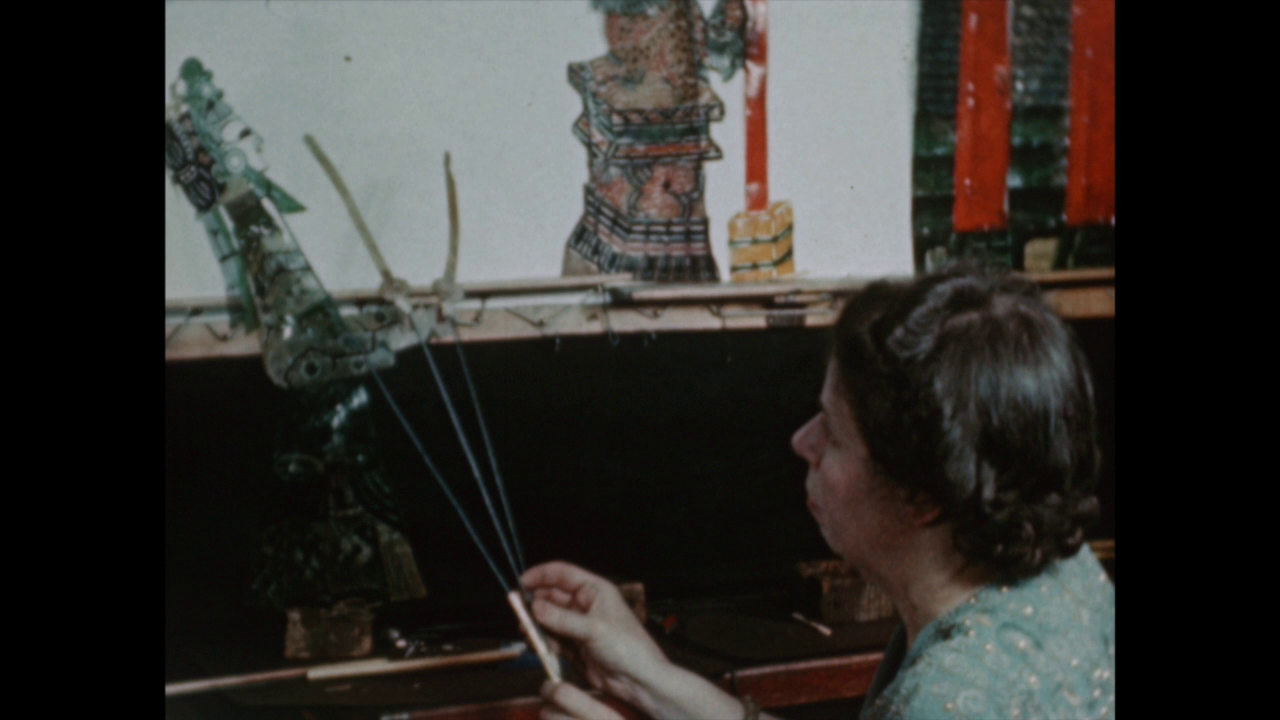
Pauline Benton performs “The White Snake Lady”. Ca.1948. From Wango Weng’s movie “Chinese Shadow Play”
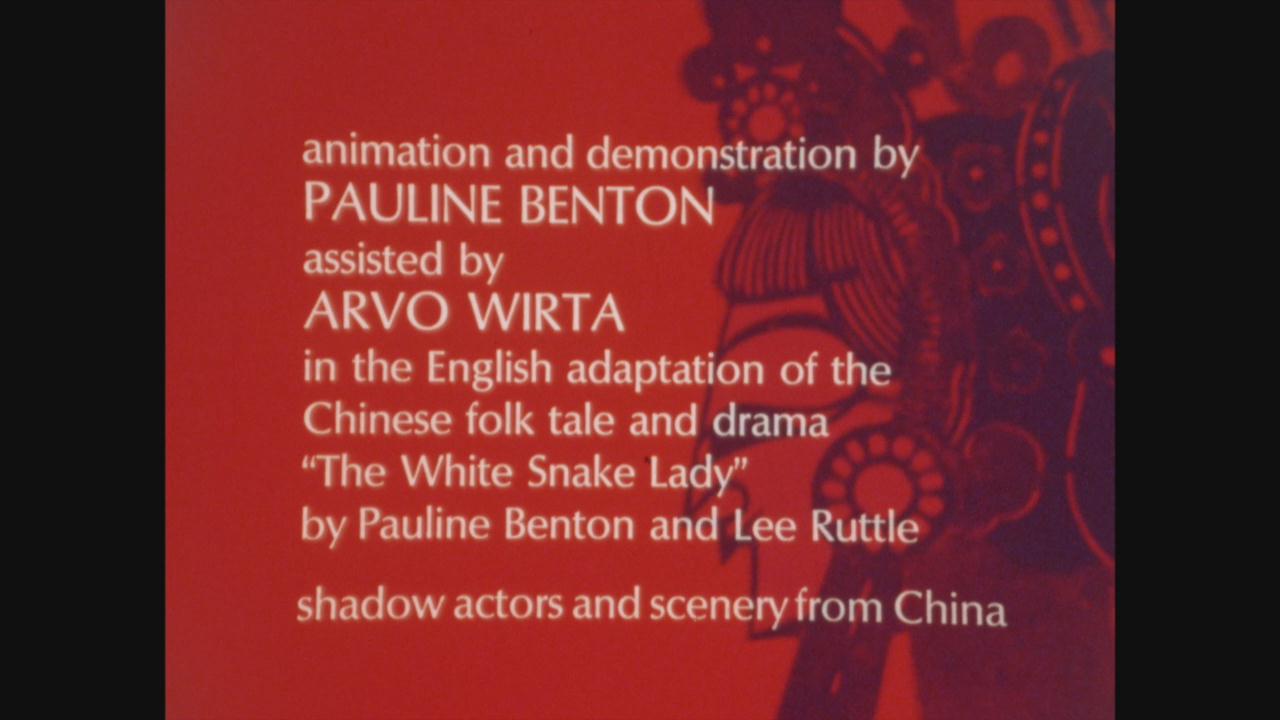
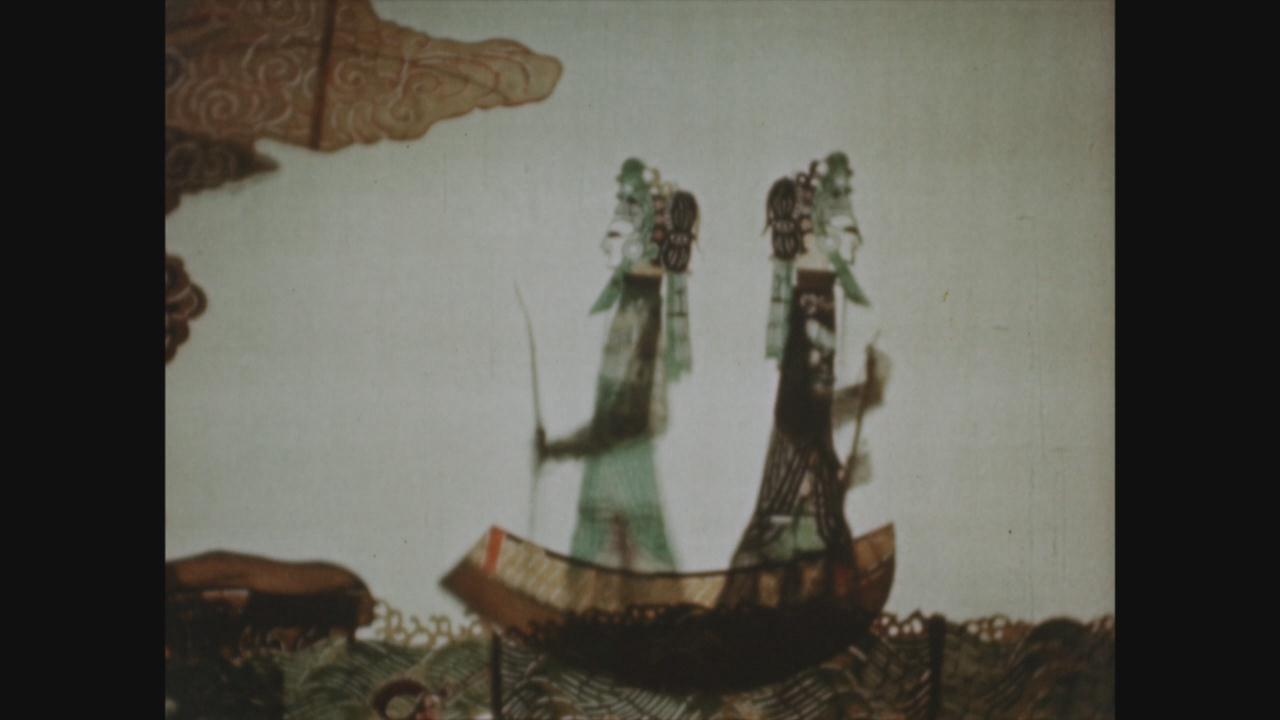
“The White Snake Lady”. Ca.1948. From Wango Weng’s movie “Chinese Shadow Play”
Benton continued to perform until the final two years of her life, when brain cancer forced her to retire. Upon her death in 1974, her will stipulated that half of the Red Gate Shadow Players' puppets were to be donated to a museum, while the other half, along with the group's stages, notes, and books, were to be sealed inside a wooden box and await the arrival of someone who could put them to good use.
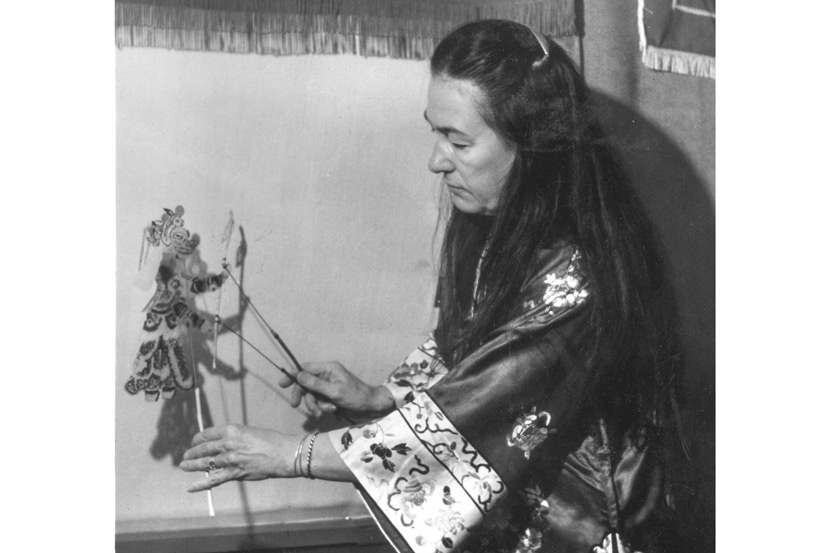
Jo Humphrey performs the 'Bull Demon King'. 1976. Courtesy of Li Mingjie
As if by miracle, that someone soon appeared: Jo Humphrey, a former drama student at the University of Southern California. During the 1940s, the Massachusetts high school, where Humphrey studied at, hosted a performance by the Red Gate Shadow Players. Humphrey, who was taken with both drama and Chinese culture, came to see shadow puppetry as the perfect blend of her two greatest passions.
Humphrey came across Laufer's collection of shadow puppets in 1972 and later showcased the collection at a number of well-received exhibitions. At heart, however, Humphrey wondered whether she could truly bring the puppets back to life. As a result of the ongoing Cultural Revolution, visiting China was out of the question. In the mid-1970s, Humphrey started to organize a six-month shadow puppetry workshop. Not long afterward, in 1976, she established the Yueh Lung Shadow Theatre in New York City.
Humphrey retired in 1999 after spending nearly a quarter-century as Yueh Lung's playwright and director. She brought a rich knowledge of ancient Chinese literature and drama to the role, and led the group as it adapted a number of classic Chinese shadow puppet plays, including "Borrowing Arrows with Straw Boats" and "Monkey King and the Mountain of Fiery Tongues." At first, she made replicas of the puppets in the museum and had actors record their lines in English, Cantonese, and Mandarin. She then set these lines to music and played them over the puppets as they moved. Although this represented a formal departure from the operatic vocal style traditionally associated with Chinese shadow puppetry, the stories she told and the medium she used to tell them remained faithful to tradition.
In the early 1990s, Humphrey's work came to the attention of one of Benton's old friends, Mercina Karam, who sought Humphrey out in order to carry out Benton's last wish. Once in possession of Benton's trove, Humphrey not only had more fresh puppets with which to work, but could also mount some of the finest pieces of Benton's collection and bring them on tour as a traveling museum exhibition. In 1993, the Yueh Lung Shadow Theatre was renamed the Gold Mountain Institute for Traditional Shadow Theatre.
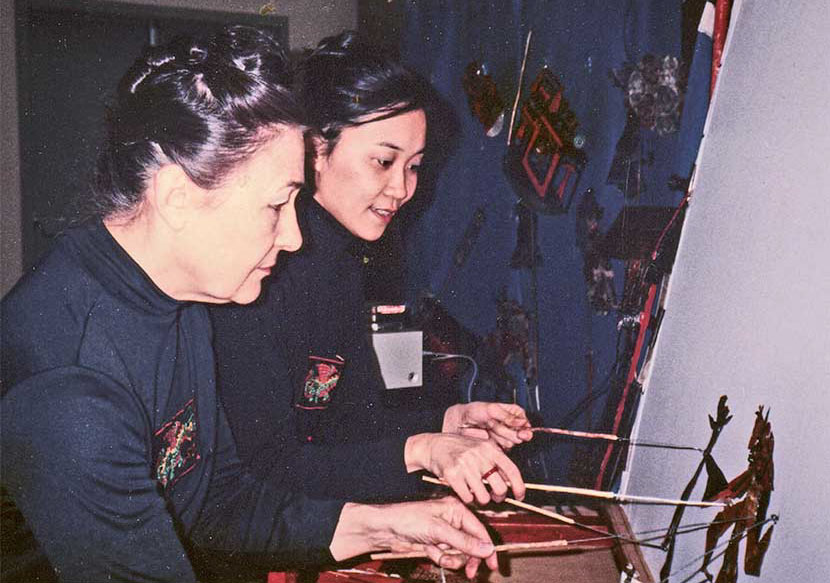
Jo Humphrey (left) and Kuang-Yu Fong (right) are behind the screen at a show in the U.S., 1986. Courtesy of Li Mingjie
Back in the early '80s, Kuang-Yu Fong, a theater student at New York University, would often get together with her classmates in the hallway of her apartment in Queens to hang out and sing pieces from traditional Chinese operas. Humphrey had an immediate appreciation for Fong's background in drama and she soon invited her to join her team as a translator, vocal performer, and teacher of traditional Chinese drama.
While Fong had little background in traditional shadow puppetry, she soon grew fascinated with the ancient craft, so deeply embedded in the marrow of Chinese drama. By chance, Fong soon met a graduate from the University of Connecticut's program in puppetry, the only such program in the U.S. The man, Stephen Kaplin, was then a student pursuing a master's degree in the performing arts at New York University.
Fong and Kaplin's shared passion for puppetry brought them together, both professionally and romantically. In 1995, they founded the Chinese Theater Workshop. When Humphrey retired in 1999, she was firm in her belief that Fong and Kaplin were the ones best positioned to carry on the tradition. The entire inventory of the Gold Mountain Institute for Traditional Shadow Theatre was given to the Chinese Theatre Workshop and the two groups formally merged in 2001 under a new name, Chinese Theatre Works.
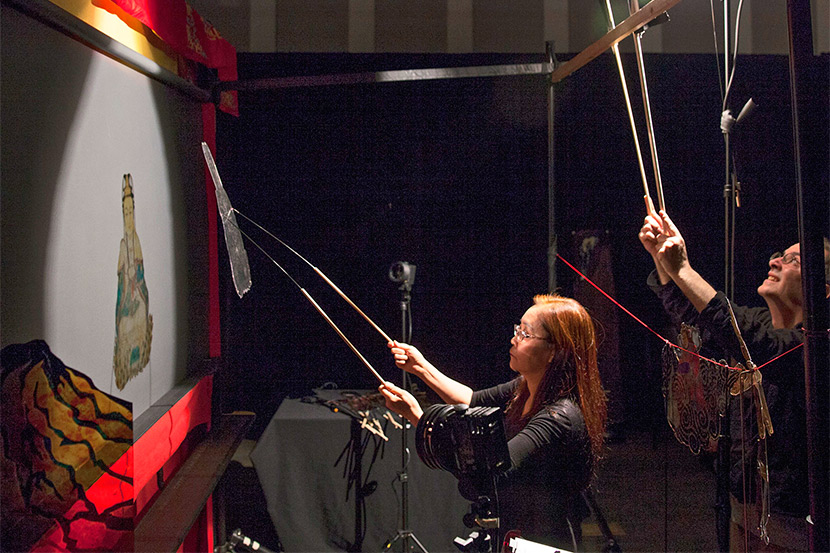
Kuang-Yu Fong (left) and Stephen Kaplin (right) perform 'Flaming Mountain' at the Field Museum in Chicago, 2015. Courtesy of Li Mingjie
Over the past 20 years, Chinese Theatre Works has produced, directed, and staged over 30 original productions. While Benton and Humphrey were primarily concerned with preserving the art, Fong and Kaplin have used this earlier conservation work as a basis for innovative new performances. Kaplin personally made all the shadow puppets for the Broadway adaptation of "The Lion King," and in "Mulan: Holding Half the Sky," the troupe used the historical tales of four women warriors — Mulan, Hongxian, She Saihua, and Qiu Jin — to depict traditional values valorized by the Chinese, including benevolence, righteousness, propriety, wisdom, and belief.
With a narrative arc stretching across millennia, largely wordless scripts, and the unique sounds of traditional Chinese zithers, lutes, and pipes, the company's spectacular performances see the colored silhouettes of puppets dash across the screen, while further props evoke the countryside, battlegrounds, and homes in which the stories take place.
While Chinese shadow puppetry was fading in popularity until its recent cultural resurgence, across the ocean in the U.S., many dramatists, some of whom had no blood ties to China, have devoted their lives to a folk art far removed from their native cultures. What united them was a quiet appreciation for the aesthetics and art of puppetry, one that stretched across countries and cultures. In her unpublished notes, Benton wrote: "The secrets of Chinese costumes, arts, architecture, religion, history, and mythology were all held in the quiet forms of the shadow figures."
Similarly, when Humphrey was asked why she, an American, was so well versed in Chinese classics like "Water Margin," "Journey to the West," and "Romance of the Three Kingdoms," she said that while the artistry behind shadow puppets was quite simple, the form of performance had the potential to be even more magical than movies or shows featuring live actors. Their stories and characters may be quintessentially Chinese, but their heroes and villains, princes and princesses, all speak to our shared humanity.
Much of our cultural heritage is conserved for display in museums, where it loses its vitality. With their passion and enthusiasm for shadow puppetry, Laufer, Benton, Humphrey, Fong, and Kaplin not only revived a swath of Chinese cultural history, but also enriched it with local American elements. Their lives speak to how even the most seemingly exotic cultural heritage testifies to the interconnectedness between civilizations.
Translator: Kilian O'Donnell; editors: Lu Hua and Matthew Walsh.